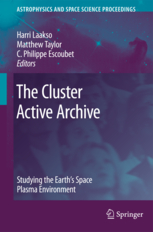ESA Science & Technology - Publication Archive
Publication archive
Publication archive
Book published in the series "Astrophysics and Space Science Proceedings"; H. Laakso, M.G.G.T. Taylor, C.P. Escoubet (Eds.), 2010, XX, 489 p., Hardcover, ISBN: 978-90-481-3498-4, © Springer
 Since the year 2000 the ESA Cluster mission has been investigating the small-scale structures and processes of the Earth's plasma environment, such as those involved in the interaction between the solar wind and the magnetospheric plasma, in global magnetotail dynamics, in cross-tail currents, and in the formation and dynamics of the neutral line and of plasmoids.
Since the year 2000 the ESA Cluster mission has been investigating the small-scale structures and processes of the Earth's plasma environment, such as those involved in the interaction between the solar wind and the magnetospheric plasma, in global magnetotail dynamics, in cross-tail currents, and in the formation and dynamics of the neutral line and of plasmoids.
This book contains presentations made at the 15th Cluster workshop held in March 2008. It also presents several articles about the Cluster Active Archive and its datasets, a few overview papers on the Cluster mission, and articles reporting on scientific findings on the solar wind, the magnetosheath, the magnetopause and the magnetotail.
The contents of the book are grouped into seven main parts:
- Part I - Products and Services of the Cluster Active Archive
- Part II - Tools for the CAA Data Analysis
- Part III - Measurement Techniques and Calibration Routines
- Part IV - Magnetospheric Missions
- Part V - Observations of Solar Wind and Magnetosheath
- Part VI - Observations of Magnetopause and Cusp
- Part VII - Observations of Magnetospheric Tail
